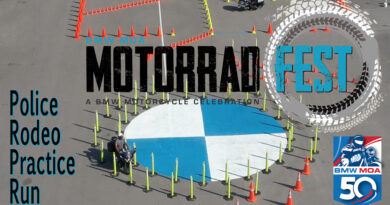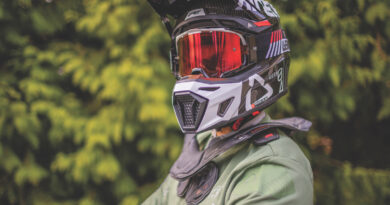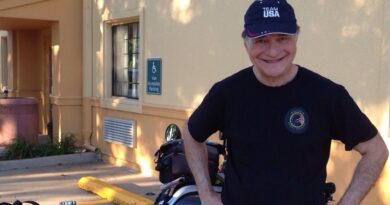Piriformis Syndrome: the anatomy of a pain in the butt
When you buy a blue bike, you notice how many others ride blue bikes. When it hurts to walk, you notice how many riders at rallies walk painfully. Most will talk about sciatic pain. Some really do have a back problem. Most have some combination of muscle and nerve pain. Orthopedics Expert Jonathan Cluett, MD tells us why exact causes are hard to pin down: It’s all theoretical. Just like that off-idle stumble in your bike, if you talk with three experts, you get four opinions.
Three different muscles connect the back to the legs: the piriformis, the psoas, and the gluteus maximus. All three become annoying when we get “saddle sore,” but the fun begins when the glutes spasm, the psoas fires up the core nerves, and the piriformis compresses the sciatic nerve. Dr. Cluett and most trainers call this the Piriformis Syndrome. Common signs and symptoms experienced by people who have been diagnosed with piriformis syndrome include:
- Pain behind the hip in the buttocks
- Electric shock pains traveling down the back of the lower extremity
- Numbness in the lower extremity
- Tenderness with pressure on the piriformis muscle (often causing pain with sitting on hard chairs)
No one has written about how this comes about for motorcycle riders, so let’s have a look at causes, conditions, cures, and prevention.

The Penny Drops
My pain in the tush fired up three years ago, when I hit the leading edge of my mid-60s. I would arrive at a rally a thousand miles from home, and find that walking was painful. It hurt worse when I stood still, talking with old friends. A nail-in-the-bone pain, that made it hard to straighten up. Sitting on sagging chairs was uncomfortable. Until year three, it did not hurt when laying down. If I stayed off the bike for a few days, the pain would go away. That would change.

When I arrived at the 2014 Top o’ the Rockies Rally in Paonia, CO, the suffering misery was on me. It would not go away. This was my first long ride on a resurrected K 75 S. For years I had ridden iterations of the RT. Those bikes can grind out the miles, but, they lack a certain panache. The low bars, the tighter tuck, and the wind rush on the S bike make for a thrilling ride. I had added a layer of high-density foam to the seat. The idea came from bicycles – the harder the seat, the longer I could go. Not so on motorcycles. I was paying the price for a failed experiment, I thought. But, as it turned out, it was not the hard foam, nor was it the position on the S bike. At the Paonia rally, I was able to remove the seat cover, yank the high-density foam out, returning the seat to the way Mike Corbin had built it. “Fixed,” I thought. To test my theory, I rode Monarch Pass and a few back roads through beautiful cuts, a 300 mile round trip from the rally. When I returned, the pain was just as bad. That night, I could not shake the pain. That was new.
Help Arrives
Lucky for me, a massage therapist had set up shop at the rally. Lynn worked on me for half an hour, releasing the hip rotators, glutes, and piriformis. For an hour, I was pain-free. I stayed off the bike the next day and got another massage. That night, the pain was reduced to a level that allowed me to dance. I thought the problem was solved. I was in the eye of a hurricane.
Lynn explained to me that the pain came from my Piriformis, a muscle deep in the hindquarter, that attaches to the tail bone on one side, and the top of the leg bone on the other. You can see it in the illustration. The swelling and tightness was causing it to press on the sciatic nerve, hence the pain that radiated down the hamstrings, into the calf, and caused my heel to tingle. “You guys,” she wagged her finger. “You ride all tucked up tight for how many miles? You’re putting a lot of pressure on the IT band, your glutes are relaxed, and that causes the Piriformis to spasm because it is doing all the butt work.” I ignored her when she said something about a shortened psoas. Once I got the piriformis sorted out, the role of the psoas in the aging long-distance rider syndrome came to the fore. More on that later.
Let Joe Muscolino, help you find your Piriformis.
I concluded, incorrectly, that the genesis of pain was the tight tuck on the S bike. I would have to figure out how to create a taller seat, and maybe lower the pegs. Discussions with several other riders who complained about sciatic pain revealed the real problem. A Canadian fellow said, “Get off the bike every 100 kilometers. Walk around.” I did the math – that’s 60 miles. Impossible. I’d seen Ardys Kellerman ride 1,000 miles without getting out of the saddle. She refueled while sitting. John Ryan rode 400 miles at a stretch with his fuel cell. Could it be that my butt was no longer iron?
Another fellow suggested Kegel exercises while riding, which he explained and demonstrated for me. Native Americans call this the Deer Exercise, which strengthens the pelvic floor. You’ve done it if you ever had to wait between pee stops. We know it by a more familiar name: Twerking. “It increases blood flow in the compressed sitting muscles and strengthens the core,” he explained.
I thought I’d try these two suggestions on the ride from Paonia to St. Paul for the BMW MOA National. But something new occurred. My butt hurt while I was on the bike. The high cost of dancing, I thought. This was new, and worrisome. I found that holding my knees as far apart as possible, a position discovered by most K bike riders with roasting thighs, for a count to 10, followed by ten seconds of twerking, relieved the pain for a few minutes. Holding the knees out relieves the shortened hip rotators and brings the muscles into balance for a sweet few minutes. Twerking increases blood flow, giving compressed nerves a breather.
I stopped every 60 miles. I hobbled around, and stretched, using techniques learned from Lisa Kinney and Andrea Borella in their Yoga and Chi Gung seminars at rallies. Warrior 1, a stretch familiar to anyone who does yoga, was effective for me. It brought some relief, enough to walk a bit before the pain went shooting down the hamstrings and into the calf, tightening them both. I stopped 50 times on the ride from Paonia to St. Paul, stretching the 1200 mile ride out to two and a half days. That was a new slow record for me, and the beginning of something wonderful. It became a “smell the roses” ride. I met locals and chatted with them. I felt the mighty wind on the high plains. I stopped in Sturgis and had a buffalo burger at the Knucklehead, then toured the Black Hills. Those seed & grain places with the high towers are a wonderful place to learn about local goings-on, and to share stories of the road with a small crowd that gathers. And, they have clean restrooms!
By the time I reached the National in St. Paul, I discovered I could not walk more than 100 feet. That is a problem when you have 5,000 friends waiting to kick tires and tell lies. Fortunately, the fairgrounds abounded with benches. I could sit and lean elbows on my knees, which allowed the spasms to subside. I researched the area at the Internet Cafe and found The American Academy of Acupuncture and Oriental Medicine a few miles away in Roseville, MN. The wonderful thing about acupuncture schools is that they have a big staff of interns who are available right now and affordable. I became a regular for three days. The needles gave me a few hours of relief. On day two, a very strong young woman who specialized in Yoga Massage took me on a Trip of Pain. She explained exactly what was going on, and prescribed a series of stretches that you can find if you search for YouTube videos with the delimiter “piriformis.”
The Causes
Nick Jack at No Regrets Personal Training in Melbourne Australia says it best. Some of this has to do with your anatomical genetic makeup, but in most cases it is due to Poor Posture, overuse or repetitive movements coupled with poor strength in the muscles that stabilize the pelvis and hip, being mainly the abdominals and glutes. As the primary muscles of the hip become fatigued, the smaller muscles, like the piriformis, work harder to maintain form. Trying to compensate for stronger muscles is how the piriformis becomes strained. Nick lhas described his wife’s adventures with piriformis syndrome in a comprehensive blog post.
Consider the sitting position on your motorcycle. With the feet spread on the foot pegs, and the glutes immobilized on the seat, the body stops dead in its tracks. This feels stable, but, as core expert Jonathan FitzGordon says, stability isn’t what we are looking for. We want a dynamic body that lives in a quiet state of perpetual motion. Try FitzGordon’s proof:
- Stand with your feet together, close your eyes, relax your butt and feel how your body stands in space.
- Then do the same thing with the feet hip-width apart or wider.
- Stand in both positions for a number of times to feel the different way the inner body reacts.
- With the feet together there is a feeling of movement within the pelvis as the gluteus medius and minimus do their internal and externally rotating thing in search of a place of balance. With the feet apart. that all tends to go away.

As we ride for long hours, our tightly bent legs put a strain on the IT band (iliotibial tract) which runs down the outer leg from hip to knee. The psoas is shortened. The gluteal muscles are relaxed, and the piriformis starts to do all the butt work. This causes it to tighten up and swell, putting pressure on the sciatic nerve, which is the source of that pain that dances along the rear hip, hamstrings, calf, and into the heel.
The Cures
I love my ice pack. Often it is the only thing that will relieve muscle pressure on the firing nerves to the point where I can function.
If your pain has reached a chronic state, as mine had, see your doctor first. He or she may prescribe anti-inflammatory and pain medications. My Doc at the VA Clinic wrote for Prednisone and suggested ibuprofen for pain. Within two days, the medications reduced swelling and pain to the point where I could start releasing trigger points and stretching. If your insurance will pay for it, the physician may prescribe a physical therapist who will help you through the following exercises. Some of us don’t have that luxury and will have to go the “Do It Yourself” route.
Release
The first thing to do is to find and release those knots, or trigger points. Myotherapist Carla Hedtke defines a trigger point as a self-sustaining irritated spot in the muscle. It causes the muscle to gradually become tighter and to shorten. This limits function and motion of the muscle causing weakness and pain. On long rides, the Piriformis contracts and holds, creating tight spots that can be found by sitting on a ball – I like a baseball, but a lacrosse ball or a tennis ball is kinder. Leaving your weight on the ball for a few minutes will release the trigger points. There is a right way and a wrong way to do it, so have a look at some web videos before you try.
- Theo Simon and the medicine ball
- Kai Wheeler and the lacrosse ball
- Brian Catania’s massage technique
Stretch
Once the trigger points are released, stretches can be a blessing.

YouTube videos offer more comprehensive instruction. Justine Shelton gets into yoga nuances, and you’ll find a variety of techniques in the sidebar of this video:
Tightness of the psoas can result in lower back pain by compressing the lumbar discs. The psoas lifts the thighs toward the belly. When we ride for long hours, the psoas is shortened, and its function is overtaken by the foot pegs. That’s how it gets tight. I believe this tightness is the first step in the process that leads to piriformis syndrome and sciatic pain for many riders Because the top of the psoas is connected to the front of the spine, rotation of the spine will release it. Simply twist the torso from side to side. You can do this to an extent while riding, and more completely at red lights. Hyperextension of the hips – in plain language, sliding the leg backward, will stretch a tight psoas. The perfect combination of these two moves – rotation and hyperextension, is the yoga pose called Warrior 1.
If you haven’t learned the pose at a yoga class, you can find excellent instruction by searching the web. Core Power Yoga offers a written how-to at corepoweryoga.com.
Real Bodywork offers a video that shows what to do, and what to avoid.
Warrior 1 is a great gas stop stretch. You can do it while filling the bike. It will loosen you up enough to enjoy a walk – which will stretch and loosen the cramped butt, and, if your lucky, lead to some roses to smell.
Strengthen
Gluteus muscles must be strengthened to avoid piriformis syndrome. K13 pilot Olga Kramar avoids piriformis syndrome by climbing 22 stories on her way to work each morning. The gluteus maximus is especially active in stair climbing. The single leg extension and flexion work the gluteus medius and the gluteus minimus.
Deep Eddie, Austin’s premier deep massage therapist, suggests three exercises for strengthening the 3 glute muscles using a theraband or exercise tubing for resistance. Bands and tubing are color-coded for strength. Eddy recommends silver for most people, which offers 40% more resistance than black, which works better if you have reached a point of low strength. I like to tie a 36” length into a circle roughly 12 to 14 inches in diameter, and slip it around my ankles for each of Eddy’s three exercises.
- Gluteus maximus
- Hold onto a table or chair for balance.
- Slowly lift one leg straight backwards without bending your knee, pointing your toes, or bending your upper body any farther forward.
- Hold the position for 45 seconds. Hold enough tension to achieve exhaustion.
- Slowly lower leg. Pause.
- Repeat with the other leg.
- Gluteus medius
- In the same posture and in the same sequence, lift one leg at a 45-degree angle, i.e., to the rear quarter
- Gluteus minimus
- In the same posture and in the same sequence, lift one leg to the side in the same sequence as the previous two exercises.
Eddy’s prescription is to work muscles for 45 seconds to exhaustion only one time (set) in any one day. Exercise different muscles two days in a row and rest on the third day for growth.
You may become one of the many long riders who suffer from sciatic pain emanating from the Piriformis Syndrome. If you know the causes and cures. it can be avoided, or at least staved off so that you may one day garner the Oldest Rider Award. See you down the road.
Acknowledgments
- Andrea Borella, BMW MOA Rally Presenter, Follow Along Qigong
- Jonathan Cluett, M.D., Orthopedics Expert
- Core Power Yoga
- Nick Jack, No Regrets Personal Training in Melbourne Australia
- Jonathan FitzGordon, Core Walking
- Carla Hedtke, Myotherapist
- Lisa Kinney, BMW MOA Rally Presenter, Relax Your Road Weary Muscles: Yoga Stretching with Lisa
- Dr. Joe Muscolino, Learnmuscles.com
- Justine Shelton, Yoga Vista Studio
- Lynn Wetherell, Massage Therapist, Paonia, CO



